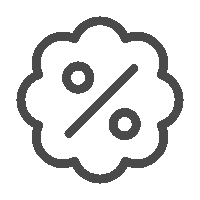Sustainability
AN ECO-FRIENDLY CHRISTMAS
We'd like to take advantage of Christmas to spread more joy and also to help the environment with a sustainable and eco friendly plan. We’re proud to be able to say that, in our product catalogue, 25% of the garments are made from 100% organic cotton. This means that 1 out of 5 products are sourced from organic crops and ecological agriculture.
We see it as our obligation to use the resources that we have at our disposal responsibly
We support ecological agriculture and organic crops.
What's the difference between organic cotton and traditional cotton?
Environmental footprint
Traditional cotton crops have resulted in the emergence of many varieties of genetically modified cotton due to overexploitation. The world's largest cotton plantations are in countries like China, India, Turkey and the United States, where most of the chemicals used to enhance productivity pollute the air and the ground, thus seriously damaging the environment.
All this has greatly reduced biodiversity in cotton crops. Further, cotton crop ecosystems are undergoing changes that are impacting their equilibrium to a worrying degree.
Conversely, ecological crops of organic cotton do not use any organically modified plants, thereby reducing the impact on the ecosystem as much as possible and minimising changes to the biological cycles.
Synthetic chemicals
In addition to not being genetically modified, ecological crops of organic cotton do not use any synthetic chemicals, such as pesticides and fertilisers.
These practices enhance cosystem equilibrium in ecological plantations, since caring for the environment is prioritised over industrial productivity. For example, cotton plantations in the United States are required to comply with the National Organic Program (NOP). This institution determines norms for organic crop management, including permitted fertilisers and pesticides for plague control.
Global production
As with most ecological crops, production of organic cotton is very limited compared to that of traditional cotton. Year after year, ecological agriculture expands in terms of hectares planted, but there is still a huge difference between organic and traditional crops.
Nevertheless, some industry initiatives have started to show support for organic cotton crops. In recent years, the area occupied by organic cotton crops has increased substantially and, on top of that, the use of synthetic chemicals has decreased by 90% in those areas.
It's up to us to ensure that the future environment is at least as habitable as it is now. We therefore have to use the resources at our disposal responsibly.
Merry Christmas!
















